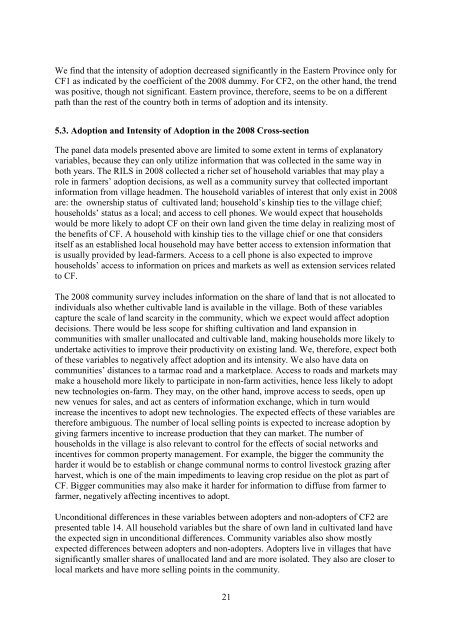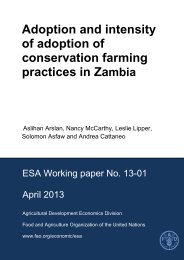Adoption and intensity of adoption of conservation farming practices in Zambia
Adoption and intensity of adoption of conservation farming practices in Zambia
Adoption and intensity of adoption of conservation farming practices in Zambia
Create successful ePaper yourself
Turn your PDF publications into a flip-book with our unique Google optimized e-Paper software.
We f<strong>in</strong>d that the <strong><strong>in</strong>tensity</strong> <strong>of</strong> <strong>adoption</strong> decreased significantly <strong>in</strong> the Eastern Prov<strong>in</strong>ce only for<br />
CF1 as <strong>in</strong>dicated by the coefficient <strong>of</strong> the 2008 dummy. For CF2, on the other h<strong>and</strong>, the trend<br />
was positive, though not significant. Eastern prov<strong>in</strong>ce, therefore, seems to be on a different<br />
path than the rest <strong>of</strong> the country both <strong>in</strong> terms <strong>of</strong> <strong>adoption</strong> <strong>and</strong> its <strong><strong>in</strong>tensity</strong>.<br />
5.3. <strong>Adoption</strong> <strong>and</strong> Intensity <strong>of</strong> <strong>Adoption</strong> <strong>in</strong> the 2008 Cross-section<br />
The panel data models presented above are limited to some extent <strong>in</strong> terms <strong>of</strong> explanatory<br />
variables, because they can only utilize <strong>in</strong>formation that was collected <strong>in</strong> the same way <strong>in</strong><br />
both years. The RILS <strong>in</strong> 2008 collected a richer set <strong>of</strong> household variables that may play a<br />
role <strong>in</strong> farmers’ <strong>adoption</strong> decisions, as well as a community survey that collected important<br />
<strong>in</strong>formation from village headmen. The household variables <strong>of</strong> <strong>in</strong>terest that only exist <strong>in</strong> 2008<br />
are: the ownership status <strong>of</strong> cultivated l<strong>and</strong>; household’s k<strong>in</strong>ship ties to the village chief;<br />
households’ status as a local; <strong>and</strong> access to cell phones. We would expect that households<br />
would be more likely to adopt CF on their own l<strong>and</strong> given the time delay <strong>in</strong> realiz<strong>in</strong>g most <strong>of</strong><br />
the benefits <strong>of</strong> CF. A household with k<strong>in</strong>ship ties to the village chief or one that considers<br />
itself as an established local household may have better access to extension <strong>in</strong>formation that<br />
is usually provided by lead-farmers. Access to a cell phone is also expected to improve<br />
households’ access to <strong>in</strong>formation on prices <strong>and</strong> markets as well as extension services related<br />
to CF.<br />
The 2008 community survey <strong>in</strong>cludes <strong>in</strong>formation on the share <strong>of</strong> l<strong>and</strong> that is not allocated to<br />
<strong>in</strong>dividuals also whether cultivable l<strong>and</strong> is available <strong>in</strong> the village. Both <strong>of</strong> these variables<br />
capture the scale <strong>of</strong> l<strong>and</strong> scarcity <strong>in</strong> the community, which we expect would affect <strong>adoption</strong><br />
decisions. There would be less scope for shift<strong>in</strong>g cultivation <strong>and</strong> l<strong>and</strong> expansion <strong>in</strong><br />
communities with smaller unallocated <strong>and</strong> cultivable l<strong>and</strong>, mak<strong>in</strong>g households more likely to<br />
undertake activities to improve their productivity on exist<strong>in</strong>g l<strong>and</strong>. We, therefore, expect both<br />
<strong>of</strong> these variables to negatively affect <strong>adoption</strong> <strong>and</strong> its <strong><strong>in</strong>tensity</strong>. We also have data on<br />
communities’ distances to a tarmac road <strong>and</strong> a marketplace. Access to roads <strong>and</strong> markets may<br />
make a household more likely to participate <strong>in</strong> non-farm activities, hence less likely to adopt<br />
new technologies on-farm. They may, on the other h<strong>and</strong>, improve access to seeds, open up<br />
new venues for sales, <strong>and</strong> act as centers <strong>of</strong> <strong>in</strong>formation exchange, which <strong>in</strong> turn would<br />
<strong>in</strong>crease the <strong>in</strong>centives to adopt new technologies. The expected effects <strong>of</strong> these variables are<br />
therefore ambiguous. The number <strong>of</strong> local sell<strong>in</strong>g po<strong>in</strong>ts is expected to <strong>in</strong>crease <strong>adoption</strong> by<br />
giv<strong>in</strong>g farmers <strong>in</strong>centive to <strong>in</strong>crease production that they can market. The number <strong>of</strong><br />
households <strong>in</strong> the village is also relevant to control for the effects <strong>of</strong> social networks <strong>and</strong><br />
<strong>in</strong>centives for common property management. For example, the bigger the community the<br />
harder it would be to establish or change communal norms to control livestock graz<strong>in</strong>g after<br />
harvest, which is one <strong>of</strong> the ma<strong>in</strong> impediments to leav<strong>in</strong>g crop residue on the plot as part <strong>of</strong><br />
CF. Bigger communities may also make it harder for <strong>in</strong>formation to diffuse from farmer to<br />
farmer, negatively affect<strong>in</strong>g <strong>in</strong>centives to adopt.<br />
Unconditional differences <strong>in</strong> these variables between adopters <strong>and</strong> non-adopters <strong>of</strong> CF2 are<br />
presented table 14. All household variables but the share <strong>of</strong> own l<strong>and</strong> <strong>in</strong> cultivated l<strong>and</strong> have<br />
the expected sign <strong>in</strong> unconditional differences. Community variables also show mostly<br />
expected differences between adopters <strong>and</strong> non-adopters. Adopters live <strong>in</strong> villages that have<br />
significantly smaller shares <strong>of</strong> unallocated l<strong>and</strong> <strong>and</strong> are more isolated. They also are closer to<br />
local markets <strong>and</strong> have more sell<strong>in</strong>g po<strong>in</strong>ts <strong>in</strong> the community.<br />
21



